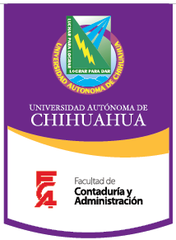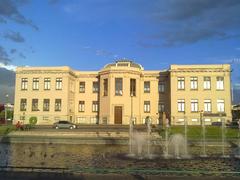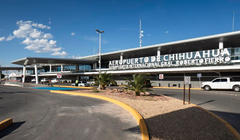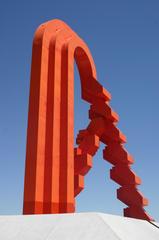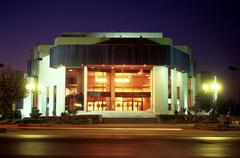Museo Histórico de la Revolución (Museo Casa de Villa) – Comprehensive Visitor Guide for Chihuahua City
Date: 04/07/2025
Introduction
The Museo Histórico de la Revolución, also known as Museo Casa de Villa or Quinta Luz, is one of Chihuahua City’s most significant historical and cultural landmarks. Housed in the beautifully preserved former residence of Francisco “Pancho” Villa, this museum stands as a living tribute to Villa’s enduring legacy and the transformative era of the Mexican Revolution. With its evocative architecture, original furnishings, personal artifacts, and richly detailed exhibits, the museum offers an immersive experience for history enthusiasts, cultural travelers, and anyone interested in exploring the roots of modern Mexico.
For official information and updates, visit the Museo Histórico de la Revolución government page, and check out additional insights at elsouvenir.com.
Table of Contents
- Introduction
- History and Evolution of Quinta Luz
- Architectural and Artistic Features
- Must-See Artifacts and Exhibits
- Visitor Information
- Preservation and Cultural Relevance
- Frequently Asked Questions (FAQs)
- Timeline of Key Events
- Visitor Tips
- Conclusion
- References
History and Evolution of Quinta Luz
Origins and Construction
Constructed between 1905 and 1907, the mansion that now houses the museum was initially owned by Corina Coupulade and later served as a slaughterhouse before Francisco Villa rented—and subsequently purchased—it in 1911 for 6,000 pesos. Major renovations occurred in 1914, with Villa naming the house “Quinta Luz” in honor of his wife, Luz Corral. The residence features neoclassical and mudejar elements, a pink cantera stone fountain, and period-appropriate interiors reflecting Villa’s aspirations and the era’s aesthetics (gob.mx; elsouvenir.com; sic.gob.mx).
Role in the Mexican Revolution
As Villa’s main residence during his governorship of Chihuahua (1913–1914), Quinta Luz became a political and military headquarters. Many pivotal meetings and strategic operations for the División del Norte—a revolutionary army led by Villa—were planned here. The property’s layout accommodated both domestic life and official functions, with rooms adapted for Villa’s family, government affairs, and military planning (sic.gob.mx; elsouvenir.com).
Transformation into a Museum
After Villa’s assassination in 1923, Luz Corral de Villa continued to live in the house, gradually turning parts of it into a private museum. In 1981, she donated the property to the Secretaría de la Defensa Nacional (SEDENA) with the condition that it be preserved as a museum. The Instituto Nacional de Antropología e Historia (INAH) led restoration efforts, and the Museo Histórico de la Revolución officially opened on November 17, 1982 (sic.gob.mx; es.wikipedia.org).
Architectural and Artistic Features
The museum complex is divided into three main sections: the main house, the rear house, and the Patio de Honor. The architecture blends neoclassical and mudejar styles, with a central courtyard, ornate fountain, and period furnishings. Notable artists, including Hilario Berumen, Manuel Portillo, and Mario Ferrer, contributed to the interior decorations and Art Nouveau elements. The Patio de Honor serves as a memorial space with busts, statues, and monuments dedicated to Villa and his allies (elsouvenir.com; sic.gob.mx).
Must-See Artifacts and Exhibits
- Dodge Brothers Automobile (1922): The bullet-riddled car in which Villa was assassinated is a centerpiece of the museum (enmexico.com.mx).
- Personal Effects: Villa’s clothing, hats, weapons (including a Winchester rifle), and Luz Corral’s belongings.
- Historical Documents: Birth certificates, correspondence, and decrees from the revolutionary period.
- Military Memorabilia: Uniforms, sabers, cannons, and other weaponry used by the División del Norte.
- Photographs and Portraits: Rare images of Villa, his family, and revolutionary companions.
- Memorials: The Patio de Honor lists Villa’s elite guard and features a symbolic fountain.
- Revolutionary Art: Murals and period artwork depicting the struggle and ideals of the revolution (mexicodestinos.com).
Visitor Information
Hours and Admission
- Tuesday to Saturday: 09:00 AM – 01:00 PM, 03:00 PM – 07:00 PM
- Sunday and Holidays: 09:00 AM – 05:00 PM
- Closed Mondays
- Admission:
- Adults: $10 MXN
- Students (with ID): $5 MXN
- Children & Seniors: $2.50 MXN
Discounts are available for groups, students, and seniors. Guided tours may have additional fees (rankeamexico.com).
Accessibility
The main exhibition halls and courtyard are generally accessible, but some areas may have limitations due to the original architecture. The ground floor is wheelchair accessible; however, the second floor is only accessible via stairs. Contact the museum ahead of your visit for specific needs.
Getting There and Parking
- Address: Calle Décima 3010, Colonia Santa Rosa, 31050 Chihuahua, Chih., México
- Public Transport: Local bus routes and ride-hailing services (Uber) are available.
- Walking: 15–20 minutes from Plaza de Armas or the Cathedral of Chihuahua.
- Parking: Limited public and street parking nearby; using public transport or rideshare is recommended (visitachihuahuacapital.com).
Guided Tours and Events
- Guided Tours: Regularly offered in Spanish; English tours available with advance request.
- Special Events: The museum hosts lectures, workshops, film screenings, and temporary exhibitions. Check the museum’s calendar or social media for updates (journeytomexico.com).
Facilities
- Restrooms: On-site.
- Gift Shop: Books, souvenirs, and memorabilia.
- Event Spaces: Used for cultural events and educational programs.
Preservation and Cultural Relevance
The museum’s preservation was enabled by Luz Corral’s vision and the support of Mexican cultural authorities. It serves as both a historical archive and an educational resource, fostering public dialogue on social justice, governance, and the complex legacy of the Mexican Revolution. The site is recognized as a vital element of Chihuahua’s civic identity and cultural memory (sic.gob.mx; 33travels.com).
Frequently Asked Questions (FAQs)
Q: What are the museum’s opening hours?
A: Tuesday to Saturday: 09:00–13:00 and 15:00–19:00; Sunday and holidays: 09:00–17:00; closed Mondays.
Q: How much does admission cost?
A: Adults: $10 MXN; Students: $5 MXN; Children/Seniors: $2.50 MXN.
Q: Are guided tours available in English?
A: Yes, with advance booking.
Q: Is the museum wheelchair accessible?
A: The ground floor and courtyard are accessible; upper floors require the use of stairs.
Q: Can I take photographs?
A: Photography is allowed in most areas without flash or tripods; check for restrictions in sensitive rooms.
Q: Is parking available?
A: Limited parking is available nearby; public transport or rideshare is recommended.
Timeline of Key Events
- 1905–1907: Construction of the original house
- 1911: Villa rents and purchases the property
- 1914: Major renovations; renamed Quinta Luz
- 1915: Villa and family flee to the U.S.
- 1920: Luz Corral returns to the house
- 1923: Villa’s assassination; Luz Corral resides there
- Post-1923: Private museum established by Luz Corral
- 1981: Donation to SEDENA
- 1982: Official inauguration as a public museum (es.wikipedia.org; sic.gob.mx)
Visitor Tips
- Best time to visit: Weekday mornings for fewer crowds.
- Language: Most exhibits are in Spanish; consider booking a bilingual guide.
- Duration: Allow 1–2 hours for a thorough visit.
- Nearby Attractions: Explore the Cathedral of Chihuahua, Plaza de Armas, Quinta Gameros, and Casa Chihuahua (mexicodave.com).
- Children: Family-friendly, with engaging exhibits for young history enthusiasts.
- Health Protocols: Check current health and safety guidelines before visiting.
Conclusion
The Museo Histórico de la Revolución (Museo Casa de Villa) is a profound testament to Mexico’s revolutionary past and Pancho Villa’s enduring legacy. Through authentic artifacts, immersive exhibits, and evocative storytelling, the museum provides visitors with a deeper understanding of Chihuahua’s role in shaping national history. Detailed interpretive materials, bilingual support, and accessible facilities ensure that every visitor can connect with this pivotal chapter in Mexico’s story. To enhance your visit, use the Audiala app for interactive guides, and stay updated with the museum’s official website and social media.
For more information, plan your visit with the official museum page and consult trusted travel resources for local insights (Travel Pander).
References
- Museo Histórico de la Revolución – Gobierno de México
- Museo Histórico de la Revolución – Elsouvenir
- INAH – Ficha del Museo
- Museo Histórico de la Revolución – En México
- Museo Casa de Villa – AD Magazine
- Chihuahua City Historical Sites – Travel Pander
- Museo Histórico de la Revolución Visitor Guide – Rankeamexico
- Visit a Chihuahua Capital – Museo Casa de Villa
- Museo Casa de Villa – Mexicodestinos
- 33travels.com
- Mexico Cassie Travel Blog
- Journey to Mexico
- Mexicodave.com

